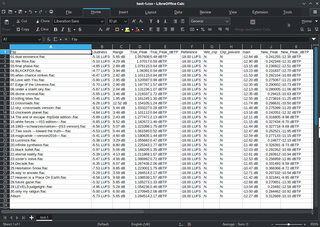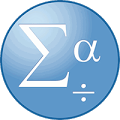
A spreadsheet is a computer application for computation, organization, analysis and storage of data in tabular form. Spreadsheets were developed as computerized analogs of paper accounting worksheets. The program operates on data entered in cells of a table. Each cell may contain either numeric or text data, or the results of formulas that automatically calculate and display a value based on the contents of other cells. The term spreadsheet may also refer to one such electronic document.

Lotus Improv is a discontinued spreadsheet program from Lotus Development released in 1991 for the NeXTSTEP platform and then for Windows 3.1 in 1993. Development was put on hiatus in 1994 after slow sales on the Windows platform, and officially ended in April 1996 after Lotus was purchased by IBM.
Lotus Symphony was an integrated software package for creating and editing text, spreadsheets, charts and other documents on the MS-DOS operating systems. It was released by Lotus Development as a follow-on to its popular spreadsheet program, Lotus 1-2-3, and was produced from 1984–1992. Lotus Jazz on the Apple Macintosh was a sibling product.
AppleScript is a scripting language created by Apple Inc. that facilitates automated control over scriptable Mac applications. First introduced in System 7, it is currently included in all versions of macOS as part of a package of system automation tools. The term "AppleScript" may refer to the language itself, to an individual script written in the language, or, informally, to the macOS Open Scripting Architecture that underlies the language.

SPSS Statistics is a statistical software suite developed by IBM for data management, advanced analytics, multivariate analysis, business intelligence, and criminal investigation. Long produced by SPSS Inc., it was acquired by IBM in 2009. Current versions have the brand name: IBM SPSS Statistics.

AppleWorks is an integrated office suite containing a word processor, database, and spreadsheet. It was developed by Rupert Lissner for Apple Computer, originally for the Apple II platform and launched in 1984, and was later reworked for the Macintosh platform.

Multi-booting is the act of installing multiple operating systems on a single computer, and being able to choose which one to boot. The term dual-booting refers to the common configuration of specifically two operating systems. Multi-booting may require a custom boot loader.

Connectix Corporation was a software and hardware company, noted for having released innovative products that were either made obsolete as Apple Computer incorporated the ideas into system software, or were sold to other companies once they became popular. It was formed in October 1988 by Jon Garber; dominant board members and co-founders were Garber, Bonnie Fought, and close friend Roy McDonald. McDonald was still Chief Executive Officer and president when Connectix finally closed in August 2003.

Windows Calculator is a software calculator developed by Microsoft and included in Windows. In its Windows 10 incarnation it has four modes: standard, scientific, programmer, and a graphing mode. The standard mode includes a number pad and buttons for performing arithmetic operations. The scientific mode takes this a step further and adds exponents and trigonometric function, and programmer mode allows the user to perform operations related to computer programming. Recently, a graphing mode was added to the Calculator, allowing users to graph equations on a coordinate plane.
Wingz was a spreadsheet program sold by Informix in the late 1980s and early 1990s. Originally developed for the Macintosh, it was later ported to Microsoft Windows, OS/2, NeXTSTEP and several other commercial flavors of Unix. In spite of many positive reviews, including one calling it "clearly the spreadsheet of the future", the market was rapidly entrenching Microsoft Excel. Informix eventually gave up on the desktop market and reverted solely to database sales in the mid-1990s. Claris licensed and sold an extensively cleaned up version as Claris Resolve in 1991, but it was far too late to market to have any effect.

Balloon help is a help system introduced by Apple Computer in their 1991 release of System 7.0. The name referred to the way the help text was displayed, in "speech balloons", like those containing words in a comic strip. The name has since been used by many to refer to any sort of pop-up help text.
Rhapsody was the code name given to Apple Computer's next-generation operating system during the period of its development between Apple's purchase of NeXT in late 1996 and the announcement of Mac OS X in 1998. At first more than an operating system, Rhapsody represented a new strategy for Apple, who intended the operating system to run on x86-based PCs as well as on PowerPC-based Macintosh hardware. In addition, the underlying API frameworks would be ported to run natively on Windows NT. Eventually, the non-Apple platforms were dropped, and later versions consisted primarily of the OPENSTEP operating system ported to the Power Macintosh, along with a new GUI to make it appear more Mac-like. Several existing "classic" Mac OS technologies were also ported to Rhapsody, including QuickTime and AppleSearch. Rhapsody could also run Mac OS 8 in a "Blue Box" emulation layer.

Stata is a general-purpose statistical software package developed by StataCorp for data manipulation, visualization, statistics, and automated reporting. It is used by researchers in many fields, including biomedicine, epidemiology, sociology and science.

Task Manager, previously known as Windows Task Manager, is a task manager, system monitor, and startup manager included with Microsoft Windows systems. It provides information about computer performance and running software, including name of running processes, CPU and GPU load, commit charge, I/O details, logged-in users, and Windows services. Task Manager can also be used to set process priorities, processor affinity, start and stop services, and forcibly terminate processes.
T/Maker was one of the first spreadsheet programs designed for the personal computer user and released by Peter Roizen in 1979. The application ran on CP/M, TRSDOS, and later on MS-DOS computers. T/Maker was originally distributed by Lifeboat Associates of New York.

In computing, the trash is a graphical user interface desktop metaphor for temporary storage for files set aside by the user for deletion, but not yet permanently erased. The concept and name is part of Macintosh operating systems, a similar implementation is called the Recycle Bin in Microsoft Windows, other operating systems use other names.
Numbers is a spreadsheet application developed by Apple Inc. as part of the iWork productivity suite alongside Keynote and Pages. Numbers is available for iOS and macOS High Sierra or newer. Numbers 1.0 on OS X was announced on August 7, 2007, making it the newest application in the iWork suite. The iPad version was released on January 27, 2010. The app was later updated to support iPhone and iPod Touch.
Integrated software is a software for personal computers that combines the most commonly used functions of many productivity software programs into one application.

SOFA Statistics is an open-source statistical package. The name stands for Statistics Open For All. It has a graphical user interface and can connect directly to MySQL, PostgreSQL, SQLite, MS Access (map), and Microsoft SQL Server. Data can also be imported from CSV and Tab-Separated files or spreadsheets. The main statistical tests available are Independent and Paired t-tests, Wilcoxon signed ranks, Mann–Whitney U, Pearson's chi squared, Kruskal Wallis H, one-way ANOVA, Spearman's R, and Pearson's R. Nested tables can be produced with row and column percentages, totals, standard deviation, mean, median, lower and upper quartiles, and sum.

Mac OS is the series of operating systems developed for the Macintosh family of personal computers by Apple Inc. from 1984 to 2001, starting with System 1 and ending with Mac OS 9. The Macintosh operating system is credited with having popularized the graphical user interface concept. It was included with every Macintosh that was sold during the era in which it was developed, and many updates to the system software were done in conjunction with the introduction of new Macintosh systems.












